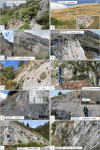QUIN 2.0 - new release of the QUaternary fault strain INdicators database from the Southern Apennines of Italy
- PMID: 38347012
- PMCID: PMC10861574
- DOI: 10.1038/s41597-024-03008-6
QUIN 2.0 - new release of the QUaternary fault strain INdicators database from the Southern Apennines of Italy
Abstract
QUIN database integrates and organizes structural-geological information from published and unpublished sources to constrain deformation in seismotectonic studies. The initial release, QUIN1.0, comprised 3,339 Fault Striation Pairs, mapped on 445 sites exposed along the Quaternary faults of central Italy. The present Data Descriptor introduces the QUIN 2.0 release, which includes 4,297 Fault Striation Pairs on 738 Structural Sites from southern Italy. The newly investigated faults span ~500 km along the Apennines chain, with strikes transitioning from ~SE to ~SW and comprehensively details Fault Striation Pairs' location, attitude, kinematics, and deformation axes. Additionally, it offers a shapefile of the fault traces hosting the data. The QUIN 2.0 release offers a significant geographic extension to the QUIN 1.0, with comprehensive description of local geometric-kinematic complexities of the regional pattern. The QUIN data may be especially relevant for constraining intra-Apennine potential seismogenic deformation patterns, where earthquake data only offer scattered or incomplete information. QUIN's data will support studies aimed at enhancing geological understanding, hazard assessment and comprehension of fault rupture propagation and barriers.
© 2024. The Author(s).
Conflict of interest statement
The authors declare no competing interests.
Figures




References
-
- Barchi, M. R. The Neogene-Quaternary evolution of the Northern Apennines: crustal structure, style of deformation and seismicity. J. Virtual Explor. 36 (2010).
-
- Papanikolaou ID, Roberts GP. Geometry, kinematics and deformation rates along the active normal fault system in the southern Apennines: Implications for fault growth. J. Struct. Geol. 2007;29:166–188. doi: 10.1016/j.jsg.2006.07.009. - DOI
-
- Roberts GP, Michetti AM. Spatial and temporal variations in growth rates along active normal fault systems: An example from The Lazio-Abruzzo Apennines, central Italy. J. Struct. Geol. 2004;26:339–376. doi: 10.1016/S0191-8141(03)00103-2. - DOI
-
- Cohen KM, Finney SC, Gibbard PL, Fan JX. The ICS International Chronostratigraphic Chart. Episodes. 2023;36:199–204. doi: 10.18814/epiiugs/2013/v36i3/002. - DOI
Publication types
Grants and funding
LinkOut - more resources
Full Text Sources

